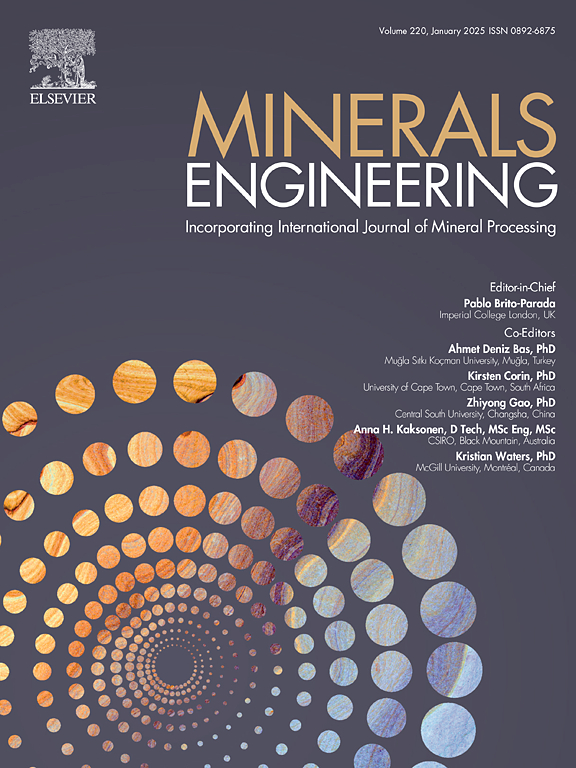从铁精矿到洁净钢:以制备高纯铁精矿为核心的绿色短工序生产技术
IF 4.9
2区 工程技术
Q1 ENGINEERING, CHEMICAL
引用次数: 0
摘要
随着钢铁产品向高端化、低碳钢化的加速转变,高纯铁精矿已成为不可缺少的原材料。本研究开发了一条绿色、短流程的清洁钢基生产工艺路线,并以基于工艺矿物学特征的新型评价体系为指导,对HPIC的制备进行了指导。通过对中国不同矿床的10个磁铁矿基铁精矿(包括化学成分、粒度和共生类型)进行表征,建立了评价体系并进行了验证。优化了预选—多段磨矿—弱磁选—电磁选—反浮选(PCMF)组合流程,获得了含TFe >的UPIC;71.8%和SiO2 <;0.3%(酸不溶性<; 0.2%)和HPIC与TFe >;70%和SiO2 <;2%,实现93%以上的总回收率。UPIC和HPIC在隧道窑中进一步转化为直接还原铁,然后在低碳电炉中熔炼,得到含TFe >的纯铁;99.90%,适用于清洁钢基应用。能源消耗模型量化了用HPIC取代传统饲料可以减少炼钢能源需求,显示出减少二氧化碳排放的巨大潜力。这一综合途径为利用国内铁矿石生产高效、低碳、清洁的钢铁提供了可扩展的战略。本文章由计算机程序翻译,如有差异,请以英文原文为准。

From iron concentrate to clean steel: A green short-process production technology centered on preparing high-purity iron concentrate
With the accelerating shift toward high-end and low-carbon steel products, high-purity iron concentrates (HPIC) have become indispensable raw materials. In this study, a green and short-process clean steel-based production process route was developed, and the preparation of HPIC was guided by a new evaluation system based on process mineralogical characteristics. The evaluation system was established and validated by characterizing 10 magnetite-based iron concentrates from different deposits in China (including chemical composition, particle size, and paragenesis type). A combined pre-concentration, multi-stage grinding–weak magnetic separation, electromagnetic separation, and reverse flotation (PCMF) flowsheet was optimized to yield UPIC with TFe > 71.8 % and SiO2 < 0.3 % (acid-insoluble <0.2 %) and HPIC with TFe > 70 % and SiO2 < 2 %, achieving overall recoveries above 93 %. The UPIC and HPIC were further converted into direct reduced iron in a tunnel kiln and then smelted in a low-carbon electric furnace, delivering pure iron with TFe > 99.90 %, suitable for clean steel base applications. An energy-consumption model quantifies that replacing conventional feed with HPIC reduces steelmaking energy demand, demonstrating significant potential for CO2 mitigation. This integrated pathway provides a scalable strategy for high-efficiency, low-carbon, clean steel production using domestic iron ores.
求助全文
通过发布文献求助,成功后即可免费获取论文全文。
去求助
来源期刊

Minerals Engineering
工程技术-工程:化工
CiteScore
8.70
自引率
18.80%
发文量
519
审稿时长
81 days
期刊介绍:
The purpose of the journal is to provide for the rapid publication of topical papers featuring the latest developments in the allied fields of mineral processing and extractive metallurgy. Its wide ranging coverage of research and practical (operating) topics includes physical separation methods, such as comminution, flotation concentration and dewatering, chemical methods such as bio-, hydro-, and electro-metallurgy, analytical techniques, process control, simulation and instrumentation, and mineralogical aspects of processing. Environmental issues, particularly those pertaining to sustainable development, will also be strongly covered.
 求助内容:
求助内容: 应助结果提醒方式:
应助结果提醒方式:


